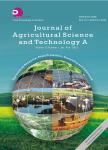Farmer Participatory Evaluation of Nursery Bed Treatments for the Control of Root-Knot Nematodes [Meloidogynejavanica (Treub) Chitwood and Meloidogyne incognita (Kofoid and White) Chitwood] in Smallholder Farms in Kenya
Farmer Participatory Evaluation of Nursery Bed Treatments for the Control of Root-Knot Nematodes [Meloidogynejavanica (Treub) Chitwood and Meloidogyne incognita (Kofoid and White) Chitwood] in Smallholder Farms in Kenya作者机构:CAB International P.O. Box 633-00621 Nairobi Kenya School of Agriculture Policy and Development University of Reading Reading RG6 6dR Berkshire UK Kenya Agricultural Research Institute - National Horticultural Research Centre P.O. Box 220-01000 Thika Kenya Rothamsted Research Harpenden Hertfordshire AL5 2JQ UK
出 版 物:《Journal of Agricultural Science and Technology(A)》 (农业科学与技术(A))
年 卷 期:2011年第1卷第5期
页 面:647-662页
学科分类:090403[农学-农药学(可授农学、理学学位)] 09[农学] 0904[农学-植物保护] 090401[农学-植物病理学]
主 题:南方根结线虫 生物控制剂 育苗床 肯尼亚 农民 治疗 农场 劳动力资源
摘 要:Root-knot nematodes (Meloidogyne spp.) constrain the production of high value vegetable crops, such as tomato, on smallholder farms in Kenya. For several years, control of root-knot nematodes largely depended on the use of synthetic nematicides, most of which have been banned due to their toxicity to humans and the environment. Farmer-participatory trials were established, for two consecutive growing seasons on farmers’ fields infested with root-knot nematodes (Meloidogyne javanica and Meloidogyne incognita), at two sites in central Kenya (Maragua and Kirinyaga districts), representing two contrasting group of farmers (low-input and high-input). The trials aimed at evaluating the potential of using biological control agents (BCAs), i. e. Pochonia chlamydosporia and Pasteuria penetrans, antagonistic plants (Crotalaria grahamiana and Tagetes minuta), trash burning and chemical control (dazomet 98% = Basamid? Granular) in the management of root-knot nematodes in tomato nursery beds, and quantify the associated net benefits, compared to an untreated control. Crotalaria grahamiana, trash burning and dazomet, significantly (P 0.05) increase in yield after transplanting tomato seedlings from the respective treatment. Similarly, one of the BCAs (P. chlamydosporia), was effectively transferred to the field with seedlings from the BCA-treated nursery beds, but there was no significant (P 0.05) increase in yield due to slow proliferation of the BCA, after transplanting. Participatory partial budgets were successfully developed with smallholder farmers, and proved to be a vital tool in making informed decisions on management options for root-knot nematodes. In general, labour was considered by all farmers as the major input that contributed to the overall additional cost of the different treatments at both sites. This necessitates improvement in efficiency of labour resource use.



